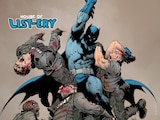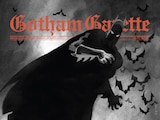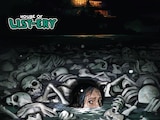If you ever want to make someone from Gotham City laugh, tell them they’re perfectly safe from Two-Face, Bane or the Joker—after all, they’re locked away in Arkham Asylum.
By the standards of a mental health facility and a prison for the protection of the public, no institution has failed Gotham on more occasions than Arkham. It doesn’t seem capable of holding anyone for very long and its most notorious patients only seem to get worse with time. Also, on occasion, Arkham does have a tendency to either get commandeered by the inmates themselves, or simply get exploded. With Arkham’s inmates roaming the streets in Arkham City: The Order of the World, as well as the immediately failed experiment of “Arkham Tower” in Detective Comics, it’s hard to imagine a more embarrassing time to be Arkham’s public relations director. But despite multiple attempts at rebranding and all the money that the Wayne Foundation can throw at it, this has been an ongoing concern since at least 1986. Let’s review the major incidents Arkham Asylum has suffered since Batman started stuffing it with people who hate him.
Resurrection Night
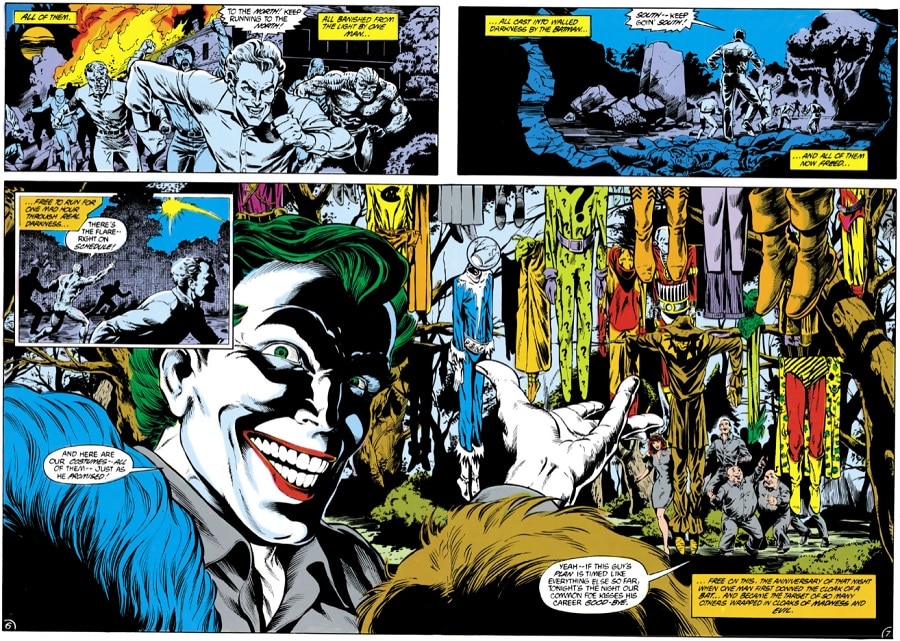
Arkham’s supervillain population has been poking holes in Arkham’s security ever since it was first introduced in 1974’s Batman #258—where, in early years, it was primarily used as a backdrop for Two-Face stories. In 1975’s The Joker series, we further discovered that Gotham’s most notorious criminal had a means of smuggling himself out of Arkham whenever he pleased, capering about and returning to his comfortable “Ha Ha Hacienda” underneath the asylum as he wished.
But those are typical failures as far as Arkham is concerned. The first known mass breakout from Arkham was recorded in 1986’s Batman #400, when a bombing rips open Arkham’s walls. The culprit, Batman discovered, was Ra’s al Ghul. The Demon wished to overwhelm his would-be heir with everyone he took half-measures with by imprisoning them. In contrast, Ra’s would offer his own more efficient alternative: kill the most burdensome members of society, he argued, and you are left with a healthier world. Of course, Batman refused this offer from his adversary to murder his enemies on his behalf, and recaptured his foes one by one, with a little help from Robin, Catwoman, and Ra’s’ own daughter, Talia.
A Serious House on Serious Earth

Three of the most popular activities in Arkham Asylum among inmates: reading, group therapy and rioting. Inmates wresting control of Arkham for themselves seems like something that happens every day, one which Batman and/or his allies show up to quell in an eye-popping montage with all your favorite supervillains. And we’ll cover some of those. But the first really serious hostage crisis was in 1989’s Batman: Arkham Asylum - A Serious House on Serious Earth, where the Joker (who else?) leads Arkham’s inmates in capturing the asylum’s staff. Their only demand: send Batman over for a game of hide-and-seek. And this deadly game was one Batman was all too willing to indulge.
The Last Arkham

1992’s Batman: Shadow of the Bat #1-4 would be the first earnest attempt to reform Arkham, as new director Jeremiah Arkham oversaw the old escape-prone death trap’s demolition and replacement with a new, state-of-the-art facility. However, new security measures essentially proved to be for show, as inmates like the serial killer Mr. Zsasz had ensured during its construction that he’d have a way to escape his cell to kill again as he pleased. But even worse was Jeremiah Arkham himself, whose tenure over the next several decades would be the most disastrous in Arkham’s history. In this very debut of his new facility, Arkham’s idea of therapy was to trap Batman himself in Arkham and give the inmates free reign to do as they pleased with him. Nobody, save perhaps the sadistic Jeremiah Arkham himself, was happy with the results.
Knightfall

The Knightfall saga of the ’90s begins with a mass breakout very similar to the one done previously on “Resurrection Night,” truly demonstrating that Jeremiah’s improvements have accomplished nothing. This time, at least the culprit and motivations are different. The masked criminal Bane was a new arrival in Gotham City, stalking Batman as a hunter does big game. Despite his massive size and strength, Bane resolved to work smarter, not harder, in breaking his chosen enemy. By breaking open Arkham and freeing Batman’s villains all at once, Bane guaranteed that Batman would be so exhausted after a night of bringing them all in that defeating him at the end of it all would be easy pickings. In contrast with Ra’s al Ghul’s aims to convert Batman to his cause, Bane would find his own goals far more realistic.
No Man’s Land

After a devastating plague, a debilitating earthquake and massive riots, Gotham City was written off by the US government and declared a No Man’s Land. All at once, every institution in Gotham failed, and the city descended into the greatest chaos it had ever experienced. And without a functioning staff or security, Arkham was left empty as its inmates poured into the streets. For most of the year-long crisis, the city had to make do without even Batman to protect it. But once he returned, he chose the only place no one else wanted to go as his base of operations to take Gotham back: Arkham itself.
Living Hell
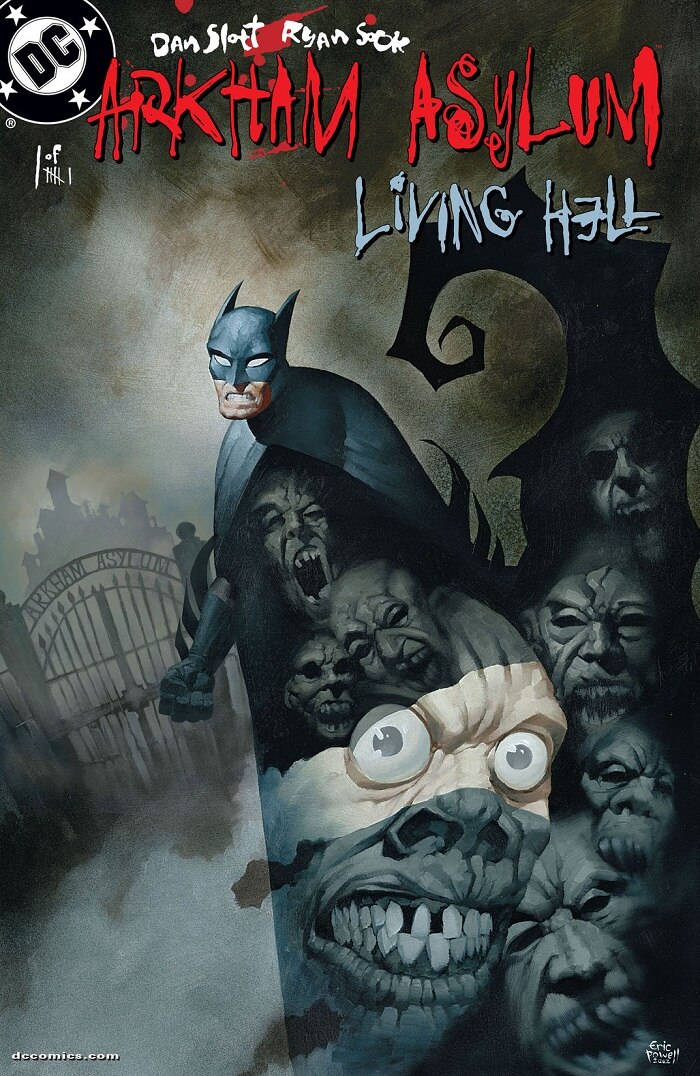
By 2003, Arkham had experienced more than its share of riots, breakouts and explosions. But only once was Arkham itself used as a nexus of madness and suffering in an attempt to conjoin Hell with our mortal realm. To be fair, it’s not the first time demons took up residence in Arkham—the first arc of Hitman being a notable example. You’d think people would be tempted to convert Arkham into a hellmouth a lot more often, if anything. And, as we’ll see later, you’d be right.
Villains United

For this incident, you can’t even blame anyone at Arkham, specifically. Their failure to secure themselves against the worldwide attack by the Secret Society of Super-Villains amounted to the same as everyone else’s. As part of the Society’s orchestrated war against all superheroes, the Society’s elite staged a mass breakout from every facility on Earth where enemies of superheroes are kept. Arkham, of course, was no exception. This worldwide incident would contribute to Amanda Waller’s plan a year later to simply ship all of the world’s super-villains to a different planet with no way back, which would turn out to be its own kind of disaster. But one you can’t blame on Arkham.
Battle for the Cowl

In 2009, the Final Crisis was over, and Batman was dead.
Okay, not really. But he was missing, and pretty much everyone thought he was dead. And with his unexpected departure, a war of egos ensued between Batman’s children to determine who, if any, would replace him as Gotham’s protector. As all this was going down, a new Black Mask emerged to wrest control of Arkham and blow it all up, including a remote Batcave installed there (presumably around No Man’s Land). Well, perhaps “wrest” is the wrong word, as this Black Mask already had control of it. For, as it turned out, the new Black Mask was in fact Jeremiah Arkham himself, who would once again use the opportunity to rebuild the asylum in his own image.
Death of the Family

At the start of the New 52 in 2011, the Joker was pretty quick to peace out and let the new universe unfold without him for a while, leaving only his own carved-off face as a farewell. A year later, the Joker was ready for his comeback in a big way. After staging attacks on each of Batman’s allies, the Joker took complete control of Arkham, transforming it into a castle for Batman—the king of Gotham, to whom he envisioned himself as truth-telling court jester. Joker relinquished his castle when Batman crossed a new line in their relationship, devastating his most storied enemy until he was ready for his big break-up letter in Batman: Endgame, where kindly Arkham orderly Eric Border revealed he had been Joker the whole time, laying low in disguise. Who is vetting these hires?
Arkham War

In 2013, a new Secret Society of Super-Villains had spread across the globe in the absence of a Justice League, all orchestrated by Earth-3’s Crime Syndicate of America. Gotham itself fell into the Penguin’s flippers, as both Arkham and Blackgate erupted into chaos. With the forces of good neutralized, it was up to the lesser evils to do what the heroes could not. In Forever Evil, Lex Luthor led a team of villains to stop the Crime Syndicate. In Rogues Rebellion, Captain Cold and his gang of Flash-haters took back Central City. And in Arkham War, Bane waged a one-man war on an unruly Arkham to prove once more that he was his foe’s equal, or better, in every way. Throughout it all, the staff at Arkham was less than useless.
Batman Eternal

Between the Joker’s two major New 52 campaigns, Arkham was completely destroyed for the third time in 2014’s Batman Eternal #30, and this time, Jeremiah Arkham wasn’t to blame. This one can be chalked up to the cult master Deacon Blackfire and a psychotic Joker fan calling herself “The Joker’s Daughter” who were enacting a dark ritual in the caves beneath the asylum to—you guessed it!—open a hellmouth and damn the world. A last-second intervention from the Spectre kept this from coming to pass, but in the process, it caused a massive collapse of the caves, swallowing the asylum above. As Arkham was rebuilt, its inmates were transferred to an alternate location in the then-abandoned Wayne Manor.
I Am Bane

Tom King’s epic run on Batman—one which still continues to play out through DC Black Label’s Batman/Catwoman—was primarily a story of two relationships: the love between Batman and Catwoman, and the hate between Bane and Batman. Early in King’s story, Bane breaches Arkham Asylum in order to take the power of Psycho Pirate and his ability to manipulate emotions. But even when Bane seems to be defeated, Batman is simply placing his enemy just where he wanted—the place where their rivalry began in Knightfall, and the place Bane conquered in Arkham War. With Psycho Pirate by his side, Bane meticulously controls Arkham and manipulates Batman’s life from the inside until Batman is exiled and Bane is free to make the city his own. But in making Arkham his birthplace, his conquest and his palace, Bane would also be designating it his tomb.
A-Day

All of the most recent Arkham-related catastrophes can be traced back to “A-Day,” a Joker gas attack on Arkham Asylum in Infinite Frontier #0 which led to a mass exodus and the deaths of hundreds—including Bane and director Jeremiah Arkham himself, who was bound to have this place be the death of him eventually. As luck would have it, most of Gotham’s most notorious criminals were out at the time (or, in Calendar Man’s case, whisked away at the last minute by the whim of Mr. Mxyzptlk). But as for the attack…was it really the Joker, or is that just what we’re supposed to think?
In The Joker, ex-commissioner Jim Gordon is no longer sure. In the meantime, what criminals could be recovered are being housed in the newly constructed Arkham Tower in the heart of Gotham, where a fresh new riot seems to be on the verge of breaking out…and just when Batman’s out of town, too. Whatever the case, we’re sure that once the Dark Knight’s allies get this situation sorted out in the heart of the city, that should be the end of it, and we can all put this dark chapter of Arkham history behind us. Right?
Keep up with the latest trouble at Arkham in the twelve-part "Shadows of the Bat" by Mariko Tamaki and Ivan Reis, which continues this week in the extra-sized Detective Comics #1050.
Alex Jaffe is the author of our monthly "Ask the Question" column and writes about TV, movies, comics and superhero history for DCComics.com. Follow him on Twitter at @AlexJaffe and find him in the DC Community as HubCityQuestion.







